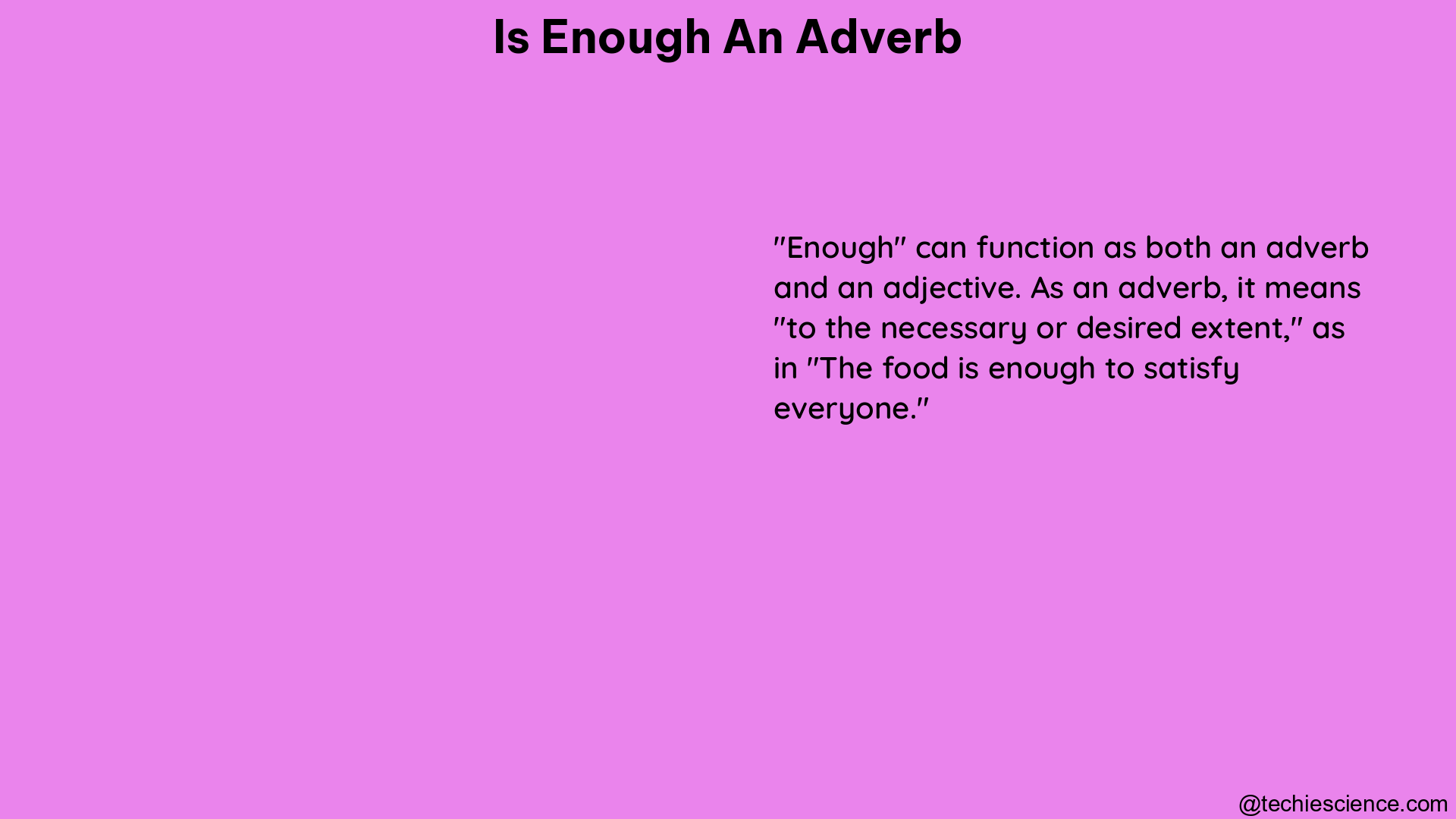Yes, “enough” can be used as an adverb. It is an adverb of degree that qualifies adjectives or other adverbs, typically in predicative position (after verbs like “to be”). However, it cannot directly qualify verbs.
Usage as an Adverb
- Qualifying Adjectives and Adverbs: Unlike most other adverbs, “enough” follows the adjective or adverb it qualifies. It is used to indicate that something has a sufficient degree or quantity of a particular quality.
Examples:
– “The room is warm enough.” (Here, “enough” qualifies the adjective “warm.”)
– “She sings beautifully enough.” (Here, “enough” qualifies the adverb “beautifully.”)
- Modification by Other Adverbs: “Enough” can be modified by adverbs such as “hardly,” “just,” “nearly,” and “quite.” These adverbs come before “enough” and the adjective or adverb being qualified.
Examples:
– “The room is just warm enough.” (Here, “just” modifies “enough.”)
– “She sings nearly beautifully enough.” (Here, “nearly” modifies “enough.”)
Contrast with Adjective and Pronoun Usage

- Adjective Usage: “Enough” can also be used as an adjective, where it comes before a noun and modifies it.
Example:
– “Do we have enough chairs?” (Here, “enough” is an adjective qualifying the noun “chairs.”)
- Pronoun Usage: “Enough” can also be used as a pronoun, where it stands on its own without modifying a noun.
Example:
– “I’ve had enough.” (Here, “enough” is a pronoun.)
Grammatical Specifics
-
Placement of “Enough”: As mentioned earlier, “enough” follows the adjective or adverb it qualifies, unlike most other adverbs that precede the word they modify.
-
Qualifying Verbs: “Enough” cannot directly qualify verbs. It can only qualify adjectives or adverbs that describe the verb.
Example:
– Incorrect: “She enough sings beautifully.” (This is not grammatically correct.)
– Correct: “She sings beautifully enough.” (Here, “enough” qualifies the adverb “beautifully.”)
-
Comparison with Other Adverbs: Unlike other adverbs that can be used to modify verbs, adjectives, and other adverbs, “enough” has a more specific function of indicating a sufficient degree or quantity.
-
Negation: When negating “enough,” the negation word (e.g., “not,” “never,” “hardly”) comes before “enough.”
Example:
– “The room is not warm enough.” (Here, “not” negates “enough.”)
- Emphasis: “Enough” can be emphasized by using adverbs like “just,” “nearly,” “quite,” or “hardly” before it.
Example:
– “The room is just warm enough.” (Here, “just” emphasizes “enough.”)
-
Collocation: “Enough” is often used with adjectives and adverbs that describe a degree or quantity, such as “big enough,” “small enough,” “fast enough,” “slow enough,” etc.
-
Idiomatic Expressions: “Enough” can also be used in various idiomatic expressions, such as “have had enough,” “good enough,” “old enough,” and “strong enough.”
Examples
- “The room is warm enough for me to sit comfortably.”
- “She sings beautifully enough to impress the audience.”
- “Do we have enough chairs for all the guests?”
- “I’ve had enough of this constant noise.”
- “The cake is not sweet enough for my taste.”
- “The athlete runs just fast enough to win the race.”
- “The weather is nearly cold enough to snow.”
References
- https://www.wordreference.com/englishusage/enough
- https://linguapress.com/grammar/points/enough.htm
- https://learnenglish.britishcouncil.org/grammar/b1-b2-grammar/using-enough
- https://portlandenglish.edu/learn-english-blog/enough/
- https://dictionary.cambridge.org/us/grammar/british-grammar/enough

Hi…. I am Goutam Datta. I have completed a double M. A. in English and B. Ed. I am a creative writer. Currently, I am a part of the LambdaGeeks.